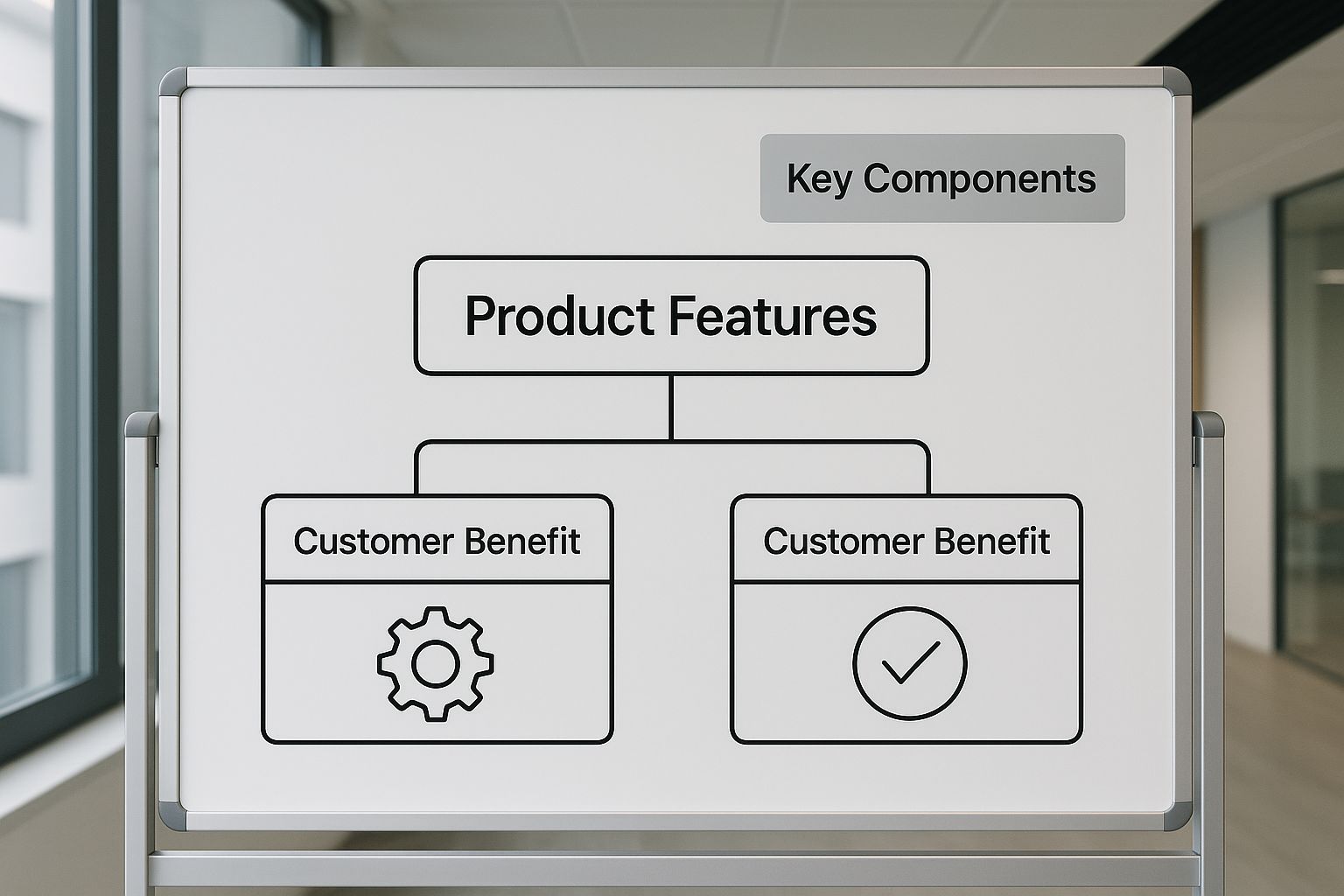A value proposition is the simple, straightforward promise you make to your customers. It’s the crystal-clear answer to their most important question: "Why should I choose you over all the other options?"
What Exactly Is a Value Proposition?
Think of it as the elevator pitch for your entire business. It's not just a clever slogan or a marketing tagline. Instead, it’s the strategic bedrock that defines what customers can expect from you and steers everything from product development to sales. It's the first and most important thing a visitor should grasp about your brand.
Without a strong one, you’re just another voice in a very crowded room. A compelling value proposition, on the other hand, makes your unique benefits shine. It clearly states the specific problem you solve, who you solve it for, and why your solution is the best one out there. That clarity is what draws in the right people and turns them into loyal customers.
While it's closely related to your company's identity, it's not the same thing. You can learn more about this by exploring the principles of crafting a solid brand promise.
To give you a quick summary, here’s a simple breakdown of what a value proposition is all about.
A Quick Look at a Value Proposition
This table shows how a value proposition works to connect your solution directly to a customer's needs, making it an essential tool for your business.
A value proposition serves as the bridge between your business and your customers. It’s a mantra that unites the two halves of the whole business, ensuring that all your hard work manifests in value for your customers every day.
The Core of Your Promise
At its heart, a value proposition is all about differentiation. It tackles the critical questions every potential customer silently asks when they first encounter your brand.
- What specific benefit are you offering? It needs to solve a real problem or satisfy a genuine need.
- Who is this for? You can't be everything to everyone, so define your ideal customer.
- What makes you different? This is your secret sauce—your competitive edge.
To really nail down what makes your brand stand out, it helps to understand the concept of a Unique Value Proposition (UVP). Getting this right is the first step toward building a memorable brand that truly connects with its audience.
The 3 Building Blocks of a Strong Value Proposition
A powerful value proposition doesn't happen by accident. It's a carefully constructed message built from a few key parts, all working together to tell a clear, persuasive story to your ideal customer. Think of it less like a single sentence and more like a structured statement with three core building blocks.
Each piece has a specific job to do. When you put them together correctly, they create a message that someone can understand in seconds. Getting this structure right is a critical first step in developing a robust brand strategy that truly connects with your audience.
Headline, Sub-headline, and Key Features
A great value proposition typically breaks down into these three key elements:
- The Headline: This is your big promise. It's a short, attention-grabbing statement that shouts the number-one benefit you offer.
- The Sub-headline: This is a 2-3 sentence explanation of what you do, who you do it for, and why you’re different. It gives the headline some much-needed context.
- Bullet Points: These are 3-5 key features or benefits that prove your headline's claim. They offer the concrete proof that makes your big promise believable.
The image below shows how these components fit together, connecting what your product does with why a customer should care.

As you can see, a great value proposition starts with a bold promise and then immediately backs it up with clear, tangible evidence.
Crafting a Cohesive Message
These building blocks ensure your message isn't just an empty claim, but a compelling argument. The headline grabs attention, the sub-headline clarifies what you're offering, and the bullet points provide the reasons to believe you.
Let's say a company's headline promises "Effortless Project Management." The sub-headline might then explain it's "for busy creative teams who need to track progress without endless meetings." Finally, the bullet points would seal the deal with features like "Automated reporting," "Real-time collaboration tools," and "Seamless integration with your existing apps."
This layered approach is what makes a value proposition so effective. Together, these elements clearly answer the what, the for whom, and the how.
How a Clear Value Proposition Fuels Business Growth
Think of a strong value proposition as more than just a snappy marketing line. It’s the very engine of your business growth. It acts as your company's North Star, making sure everyone—from the product team to your sales and marketing folks—is pulling in the same direction, focused on delivering what your customers truly want.
This clarity is what gives you a real competitive edge. Instead of just rattling off a list of features, you're communicating the real, tangible benefits that connect with your target audience. It’s what makes your brand stick in their minds and highlights why you're the only choice that makes sense. Honestly, when you nail this promise, every other business decision just gets simpler and more impactful.
Driving Acquisition and Loyalty
A well-crafted value proposition directly boosts two of the most critical metrics for any business: customer acquisition and retention. It’s the foundation that separates you from the noise in a crowded market and fundamentally shapes how people find you and why they decide to stay.
A strong value proposition is the art of staking out a piece of mental real estate for your brand by crafting and communicating a differentiated customer value proposition. Success depends not only on your intent but on how consumers perceive, classify, and remember your brand relative to competitors.
For attracting new customers, a clear value proposition instantly answers the question, "Why should I choose you?" This makes your marketing campaigns far more effective and can even lower your acquisition costs.
For your existing customers, consistently delivering on that core promise builds unshakable trust and loyalty. It’s no surprise that businesses with a solid value proposition see more customers turning into advocates, which creates a powerful cycle of repeat business and word-of-mouth referrals.
This alignment also streamlines your internal work. When you're doing branding and market research, you know exactly which customer needs to explore and which messages to test. It creates a feedback loop of constant insight and improvement that keeps you ahead of the curve.
Great Value Proposition Examples from Top Brands
Theory is one thing, but seeing a great value proposition in action is where the real learning happens. When you look at how successful brands communicate their core promise, you can see all those building blocks we talked about come to life. These companies aren't just selling a product; they're selling a clear, compelling outcome.
Let's start with Slack. Its value proposition isn't about being another messaging app. Not at all. Instead, its headline promises something much bigger: “Move faster with your tools in one place.” Right away, that hits on a major headache for modern teams—wasted time and energy from bouncing between scattered apps and information.
Slack: More Than Just Messaging
Slack’s promise of a more productive workday is delivered through simple, powerful messaging. It’s aimed squarely at teams who are fed up with endless email chains and information trapped in silos.

Here's a quick breakdown:
- Who it’s for: Teams of all sizes, from tiny startups to massive enterprises.
- What it solves: Disjointed communication and chaotic workflows.
- What you get: A central hub that brings tools and conversations together, which saves time and makes teamwork smoother.
And this approach clearly works. Slack is used by over 77% of Fortune 500 companies because it delivers on that specific, valuable promise.
Shopify: Empowering Entrepreneurs
Now, let's look at Shopify. Its value proposition is crystal clear: “The global commerce platform.” This isn't just a website builder; it's an entire ecosystem for anyone who wants to sell something online. This promise is incredibly powerful, especially with e-commerce booming.
The global B2C e-commerce market reached a staggering $4.8 trillion in 2023 and is expected to nearly double to $9 trillion by 2032. Shopify’s promise to give you everything you need to start, run, and grow a business resonates deeply with aspiring entrepreneurs in this massive market. You can explore more about these e-commerce trends on Shopify's blog.
A great value proposition doesn’t just describe your product—it defines the future success a customer can achieve with it. It shifts the focus from "what it is" to "what it does for me."
Both Slack and Shopify are masters at this. They focus on the customer’s ultimate goal, not just their own features. They lead with the transformation their platform makes possible, turning their offer from a "nice-to-have" into something their target audience can't imagine living without.
Adapting Your Promise to Modern Customer Values
Your value proposition isn't a "set it and forget it" statement. It needs to live and breathe, changing right alongside your customers. The promises that worked five years ago might fall completely flat today.
Modern buyers are different. They don't just buy products; they buy into brands that mirror their own beliefs. This shift means your core message has to connect with what they genuinely care about right now.
Weaving Values into Your Brand's Promise
We're talking about more than just features and price tags. Today, values like sustainability, ethical sourcing, and social responsibility are front and center. They've moved from the fringe to become major factors in why someone chooses one brand over another.
But here’s the crucial part: you have to mean it. Authenticity is everything. Just slapping a "green" sticker on your packaging won't cut it. These values need to be woven into the very fabric of your company.
For new businesses, getting this right from the start is a huge advantage. Our guide to branding for startup companies dives deeper into how to build these principles into your identity from day one.
The numbers back this up. A 2023 IBM report found that almost 60% of consumers will actually change how they shop to lessen their environmental impact. This is a massive opportunity for brands whose ethical stance is a real part of their value.
A great value proposition answers not just "What's in it for me?" but also "What does buying this say about who I am?"
To get this right, you have to listen. Really listen. Digging into Voice of Customer (VoC) examples is a fantastic way to understand what people truly want from the brands they support.
When you align what you promise with what your customers value, you stop being just a product on a shelf. You build a real, lasting connection.
Answering Your Top Value Proposition Questions
Even when you've got the basics down, a few questions always seem to pop up when it's time to actually write a value proposition. Getting these straight can save you a lot of headaches and help you craft something that truly connects with your audience. Let's dig into a few of the most common ones.
The first big question is usually about the difference between a value proposition and a slogan. Think of it this way: a slogan is pure marketing gold, designed to be catchy and stick in your head. Nike's "Just Do It" is the perfect example—it's memorable, not descriptive.
A value proposition, on the other hand, is a clear promise. It gets right to the point and explains the tangible benefits a customer will get by choosing you. While a slogan is about brand spirit, a value proposition is the direct answer to a customer’s biggest question: "What's in it for me?"
How Long Should a Value Proposition Be?
People often get hung up on length, but there's no strict word count. The real goal is clarity and speed. A great value proposition usually has a punchy headline, maybe five to ten words long.
That headline is often followed by a short paragraph or a few bullet points to add a bit more detail. The key is that a visitor should land on your page and understand exactly what you offer in a matter of seconds.
Your value proposition should be instantly understood. If you find yourself having to explain your explanation, you’ve missed the point. It's a promise that shouldn't need a translator.
Can My Company Have More Than One?
This is a great question, and the answer isn't a simple yes or no. Every company should have one primary value proposition. This is your North Star—the big, overarching promise that defines your brand in the market.
However, it's not only okay but smart to have different, more specific value propositions for individual products or customer groups. For instance, a software company's main promise might be "effortless project management for creative teams." But a specific feature, like a new AI-powered scheduler, could have its own value proposition: "schedule your entire team's week in under 60 seconds." This lets you tailor your message without losing sight of your core brand promise.
Ready to build a brand identity that communicates your unique value proposition with impact? The expert designers at Softriver handcraft logos and brand guides that make your promise unforgettable. Start building your brand today.







